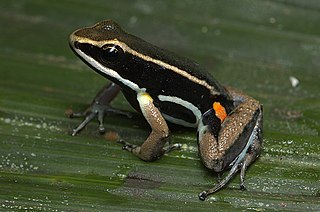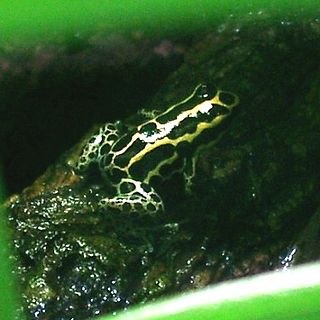
Aromobates, sometimes known as the skunk frogs, is a genus of frogs from the Andes of Venezuela and Colombia. Originally a monotypic genus consisting of the skunk frog, Aromobates nocturnus alone, it was later expanded to include Nephelobates. These frogs are difficult to differentiate from Allobates without using molecular markers.

Dendrobates is a genus of poison dart frogs native to Central and South America. It once contained numerous species, but most originally placed in this genus have been split off into other genera such as Adelphobates, Ameerega, Andinobates, Epipedobates, Excidobates, Oophaga, Phyllobates and Ranitomeya, leaving only five large to medium-sized species in the genus Dendrobates. All the other genera used to be grouped in with Dendrobates because it was previously thought that all brightly colored poison dart frogs came from the same ancestor but this has since been proven to be incorrect. Dendrobates and Phyllobates evolved conspicuous coloration from the same common ancestor but not the same as any of the other genera listed above.

Epipedobates is a genus of poison dart frogs native to northern South America west of the Andes, including the western slopes. Common name phantasmal poison frogs has been suggested for the genus.

The Aromobatidae are a family of frogs native to Central and South America. They are sometimes referred to as cryptic forest frogs or cryptic poison frogs. They are the sister taxon of the Dendrobatidae, the poison dart frogs, but are not as toxic as most dendrobatids are.
Hyloxalus cevallosi, also known as Palanda rocket frog, is a species of poison dart frogs in the family Dendrobatidae. It is named after Gabriel Cevallos García, a famous Ecuadorean writer. This species of frog occurs on the east side of the Andes in Ecuador in the Pastaza Province. Its natural habitats are very humid premontane and pluvial premontane forests.
Colostethus latinasus is a species of frog in the family Dendrobatidae. It is known from Cerro Pirre in Darién Province, Panama, from Chocó Department in adjacent Colombia, and from Tierralta, Córdoba Department, Colombia.
Colostethus mertensi is a species of frog in the family Dendrobatidae, Endemic to Colombia.

Rheobates palmatus is a species of frog in the family Aromobatidae. It is the type species of genus Rheobates erected in 2006. Its common name is palm rocket frog. It is endemic to Colombia. It is considered to be part of a species complex.

Colostethus panamansis, also known as the Panama rocket frog or (ambiguously) common rocket frog, is a species of poison dart frog. It is found in northwestern Colombia and Panama. It is one of the best studied poison dart frogs; however, until 2004 Colostethus panamansis was considered a synonym of Colostethus inguinalis, and consequently the older literature uses that name.
"Colostethus" poecilonotus is a species of frog that is endemic to Peru. It is only known from the holotype collected in the Amazonas Region. Its generic placement is uncertain, with the temporary genus designation as "Colostethus" within the family Dendrobatidae.
Colostethus thorntoni is a species of frog in the family Dendrobatidae. It is endemic to Colombia where it is known from the Cordillera Central in the Antioquia Department.

The blue-bellied poison frog or bluebelly poison frog is a species of frog in the family Dendrobatidae.

Hyloxalus is a genus of poison dart frogs, family Dendrobatidae. The genus is distributed in Central and South America, from Panama south to Peru, along with Venezuela, Colombia, and Ecuador. They also inhabit the eastern foothills of the Andes in Bolivia to Venezuela, east to the upper Amazon Basin.

Ameerega is a genus of poison dart frogs in the family Dendrobatidae. These frogs live around rocks that are nearby streams. They are found in central South America north to Panama. It contains many former species of the genus Epipedobates.

Silverstoneia is a genus of poison dart frogs from southern Central America and northern South America, between southwestern Costa Rica and southwestern Colombia. It is named in honour of Phillip A. Silverstone, an expert on dendrobatoid frogs.

Adelphobates is a small genus of poison dart frogs. They are found in the central and lower Amazon basin of Peru and Brazil, possibly Bolivia. It was originally erected as a sister group to the Dendrobates and Oophaga genera. The validity of the genus is still being discussed, with the alternative being "Dendrobates galactonotus group" within Dendrobates. One species originally placed in this genus as Adelphobates captivus has since been moved to the genus Excidobates erected in 2008.

Ranitomeya is a genus of dart poison frogs found in Panama and South America south to Peru and Brazil, possibly into Bolivia.

Dendrobatinae is the main subfamily of frogs in the family Dendrobatidae, the poison dart frogs of Central and South America, found from Nicaragua to the Amazon basin in Brazil.

Anomaloglossus is a genus of frogs in the family Aromobatidae. The genus is endemic to the Guiana Shield in northern South America. It used to be placed in the family Dendrobatidae, and is still placed in that family by some sources. The name of the genus, from the Greek anomalos and glossa (=tongue), refers to the unusual tongue bearing the median lingual process, the only unambiguous phenotypic synapomorphy of this genus.

Rheobates is a genus of frogs in the family Aromobatidae. It is endemic to Colombia. These are cryptically coloured frogs with extensive toe webbing. The name Rheobates is derived from the Greek words rheo and βάτης bátēs, in reference to the riparian habitat of the type species Rheobates palmatus. They are associated with streams in sub-Andean forests and foothills of the Andes at low to medium altitudes.














